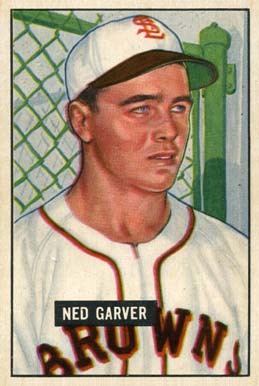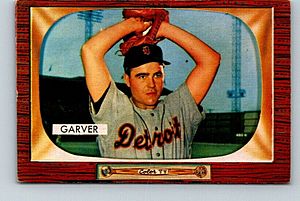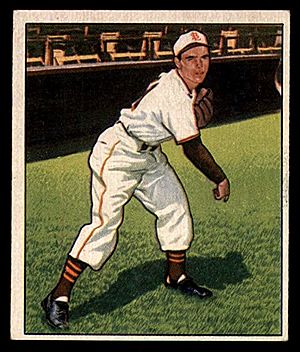Ned Garver facts for kids
Quick facts for kids Ned Garver |
|||
|---|---|---|---|

Garver in 1956.
|
|||
| Pitcher | |||
| Born: December 25, 1925 Ney, Ohio, U.S. |
|||
| Died: February 26, 2017 (aged 91) Bryan, Ohio, U.S. |
|||
|
|||
| debut | |||
| April 28, 1948, for the St. Louis Browns | |||
| Last appearance | |||
| June 4, 1961, for the Los Angeles Angels | |||
| MLB statistics | |||
| Win–loss record | 129–157 | ||
| Earned run average | 3.73 | ||
| Strikeouts | 881 | ||
| Teams | |||
|
|||
| Career highlights and awards | |||
|
|||
Ned Franklin Garver (born December 25, 1925 – died February 26, 2017) was an American professional baseball pitcher. He played in Major League Baseball (MLB) for 14 seasons. Ned played for the St. Louis Browns (1948–1952), the Detroit Tigers (1952–1956), the Kansas City Athletics (1957–1960), and the Los Angeles Angels (1961).
Garver is famous for a special achievement in 1951. He won 20 games for the St. Louis Browns, even though his team lost 102 games that year! This was a very rare feat. Only one other pitcher in the 20th century did this for a team that lost 100 games.
Ned grew up in Ney, Ohio, and loved the Detroit Tigers. He signed with the Browns in 1944 and reached the major leagues in 1948. After a neck injury in 1952, he changed his pitching style. He learned to change how fast he threw the ball and the angle of his throws. This helped him stay in the major leagues until 1961. After his baseball career, he became a farmer and even served as the mayor of his hometown, Ney.
Contents
Early Life and Baseball Dreams
Ned Franklin Garver was born on Christmas Day in 1925. He grew up on a wheat farm in Ney, Ohio. Ned was one of five children. His dad encouraged him to play baseball, even though his mom wanted him to be a preacher. Ned's dad had been a good amateur pitcher himself.
Ned loved the Detroit Tigers, the closest MLB team to his home. He remembered waking up very early to finish chores. This way, his family could go to Briggs Stadium to watch baseball games. They often watched two games in one day, called a doubleheader. Since they didn't have money for snacks, they brought sandwiches from home.
Ned started pitching for his town's local semi-pro team. He also played baseball and basketball at Ney High School. In 1943, his high school baseball team made it to the state championship.
Three MLB teams were interested in Ned. But he joined the United States Naval Air Corps in 1943. He was discharged the next spring because he had flat feet. So, he was able to sign a minor league contract with the St. Louis Browns.
Starting His Professional Journey
Minor League Years (1944–1947)
Ned Garver began his professional career in 1944. He was 18 years old. He played for the Newark Moundsmen, a team linked to the St. Louis Browns. On July 19, he threw a no-hitter! This means no one on the other team got a hit.
He won 21 games that year, leading his league. He also had the best earned run average (ERA) at 1.21. This means he allowed very few runs. Ned helped his team win the league championship.
In 1945, he moved up to higher minor league teams. He played for the Elmira Pioneers and the Toledo Mud Hens. He pitched as both a starting pitcher and a reliever. From 1946 to 1947, he played for the San Antonio Missions. The Browns almost called him up to the major leagues in 1947.
St. Louis Browns (1948–1952)
1948: First Steps in MLB
Ned went to spring training with the Browns in 1948. His manager, Zack Taylor, was impressed. Ned made the team's roster. His first MLB game was on April 28, but he was a pinch runner, not a pitcher.
His first game as a pitcher was on May 9. He felt nervous and gave up three runs in the first inning. But he pitched five scoreless innings after that. He got his first win on May 22, allowing only two runs. Ned pitched in 38 games that year. He had a 7–11 record with a 3.41 ERA.
1949: Leading the Pitching Staff
In 1949, Ned was the Browns' Opening Day starter. He started their first game for four years in a row. He pitched a complete game against the Cleveland Indians, beating their star pitcher Bob Feller. Ned called this win "special."
He threw his first major league shutout on June 29. He held the White Sox to five hits in a 1–0 win. Ned finished the year with a 12–17 record. He tied for the most losses in the American League (AL). But his team often didn't score many runs for him.
1950: A Workhorse Pitcher
In 1950, Ned pitched 10 scoreless innings against the Tigers. His team lost in the 11th inning. The Browns' relief pitchers struggled that year. So, Ned often pitched entire games. He completed 17 of his last 18 starts.
Ned led the AL with 22 complete games in 1950. He had a good ERA of 3.39. His record was 13–18 for the Browns, who had a losing record.
1951: The Amazing 20-Win Season
On June 1, 1951, Ned threw a shutout against the Red Sox. He even got two hits himself! He missed two weeks in June due to arm soreness. But Casey Stengel, a famous manager, chose Ned to start the All-Star Game. Ned called this "one of the biggest thrills."
On August 24, Ned pitched in a special game called "Grandstand Managers Night." Fans used signs to vote on team decisions. Ned recalled a time when fans voted to play the infield in, which was not a good idea. The catcher, Sherm Lollar, stalled the game until fans changed their vote. Ned then got a double play and won the game.
In the last game of the season, Ned needed one more win to reach 20 wins. He hit his only home run of the year to help his team. He pitched a complete game, and the Browns won 9–5. Ned reached 20 wins! The Commissioner of Baseball sent him a special award.
In 1951, Ned had a 20–12 record. His ERA was 3.73. He won 38% of his team's total victories. The Browns finished last in the AL with a 52–102 record. This made Ned the first pitcher since 1924 to win 20 games for a last-place team. He led the AL with 24 complete games.
1952: Injury and a New Team
Before the 1952 season, Ned became the highest-paid player on the Browns. He started the year strong with two shutouts. But while practicing, he hurt his neck. He pinched a vertebra, which is a bone in your spine. This injury changed how he pitched forever. He also battled arm fatigue.
On August 14, Ned was traded to the Detroit Tigers. This was a big trade involving several players.
Detroit Tigers (1952–1956)
1952: A Dream Come True
Ned was thrilled to join the Tigers, his favorite team growing up. But he only made one start before his arm soreness forced him to stop playing for the rest of the season. A doctor later helped his elbow, but Ned said he was "never as good after that." Still, he found new ways to pitch by changing speeds and arm angles.
1953: Battling Injuries
In 1953, Ned hurt his left knee. It would often pop out of place during games! Someone had to pop it back in so he could keep pitching. This knee injury made it hard for him to move. It also caused back problems. Despite these issues, Ned pitched 10 or more innings four times. He finished with an 11–11 record.
1954: A Strong Comeback
Ned started 1954 with a shutout against the Baltimore Orioles. He had a great ERA in his first five games. He threw two more shutouts that year. His general manager said Ned seemed more confident. Ned finished with a 14–11 record and a strong 2.81 ERA. He tied for fifth in the league with 16 complete games.
1955: Playing for a Winning Team
The 1955 Tigers were Ned's first winning team in MLB. On June 7, he pitched 12 innings in a game against the Yankees. He won when his teammate hit a home run in the 12th inning. Ned had a good July, winning five straight starts. He finished the year with a 12–16 record.
1956: Another Injury and Trade
Before his first start in 1956, Ned hurt his elbow again. This time, it happened while throwing curveballs in cold weather. Some thought his career might be over. He only pitched in six games that year. On December 5, Ned was traded to the Kansas City Athletics.
Kansas City Athletics (1957–1960)
1957: New City, New Start
Ned liked playing for the Athletics in Kansas City. He said it felt like a small town. The team gave him more rest between starts because of his past injuries. Still, he led the team in starts and innings pitched. On May 31, he won his 100th career game. He also threw a two-hit shutout on August 11. He finished with a 6–13 record.
1958: Opening Day Shutout
Ned was the Opening Day starter for the Athletics in 1958. He threw a 5–0 shutout against the Indians. He also had two more shutouts in May. On August 13, he pitched 11 innings in a game, earning the win. Ned had a 12–11 record that year.
1959: Strong Pitching and Hitting
Ned was the second-best starter for Kansas City in 1959. He threw a five-hit shutout in April. On June 21, he pitched a three-hit shutout. He also helped his team by hitting a double and a home run in that game! On July 5, he got hits in all four of his at bats, including another home run. He finished with a 10–13 record.
1960: Moving to the Bullpen
Ned struggled at the start of 1960. He lost his first five games. So, he was moved to the bullpen as a reliever. He returned to starting games in late August. He finished the season strong, throwing two shutouts in his last starts. He had a 4–9 record.
Los Angeles Angels (1961)
The Los Angeles Angels picked Ned in the 1960 expansion draft. He was mostly used as a relief pitcher. Ned found it hard to adjust to this role. He said his arm wasn't used to warming up often. His last game was on June 4, 1961. The Angels released him shortly after.
Ned decided to retire from baseball. Other teams were interested in him, but he chose to stop playing.
Career Highlights
Ned Garver played in 402 MLB games. He started 330 of them. He had a career record of 129 wins and 157 losses. His career ERA was 3.73. He struck out 881 batters. Ned threw 153 complete games, including 18 shutouts.
As a hitter, Ned was pretty good for a pitcher. He had a .218 batting average. He hit seven home runs and had 72 RBI (runs batted in).
Pitching Style
Ned Garver didn't throw the ball as fast as many other MLB pitchers. His main pitch was a sinking fastball. He also learned to throw a slider in 1947. He said this pitch helped him get to the major leagues and stay there. He had two types of sliders, one for left-handed batters and one for right-handed batters.
Ned was best when he kept the ball low and on the edges of the strike zone. He wanted batters to hit the ball early. After his injury in 1952, he learned to change speeds and throw from different angles. He would throw overhand, underhand, and sidearm. He sometimes used a tiny bit of baby oil on his cap to get a better grip on his sinking fastball late in games.
Ned had ways to stay calm during tough moments. He would tell himself the game was just starting to relax. He also looked at a far-off sign in the stadium to clear his mind.
Like many players, Ned had superstitions. When pitching, he always led with his left foot when crossing the third base line. He never stepped directly on the line. He also preferred to pick up the ball from the ground to start an inning. And after each out, he wanted the third baseman to throw him the ball.
Life After Baseball
Ned Garver never played for a team that finished in the top half of the league. But he didn't mind. He said he loved the St. Louis Browns because they gave him a chance to play. Even famous hitter Ted Williams said he had "trouble" hitting against Ned.
After his baseball career, Ned and his family moved back to Ney, Ohio. He invested in farms and worked as a farmer. He also worked at a meat packing facility for 18 years. Ned served on Ney's Village Council and Park Board. He was also the mayor of Ney for several years.
Family Life
Ned married Dorothy Sims, who was also from Ney, while he was still in high school. Dorothy supported his baseball career. She would drive to the cities where he played, even with young children. They had three children: Donnie, Chery, and Ned Alan. When their kids were in school, Dorothy would stay in Ney. Then, in the summer, they would rent a home near Ned's team.
Dorothy passed away in 1995. Ned remarried in 2001 to Dolores Hart. His nephew, Bruce Berenyi, also became an MLB pitcher. Ned Garver died from heart failure on February 26, 2017, in Bryan, Ohio. He was 91 years old.




